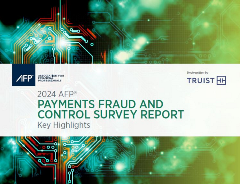Check fraud remains a persistent and evolving threat within the financial industry, despite the overall decline in check usage. Although digital transactions have surged, a significant portion of businesses and individuals still use checks, fueling an upward trend in check-related fraud. Recent reports indicate an increase in fraudulent activities, impacting both financial institutions and their members.
Don Samuels, Senior Sales and Business Development Executive at OrboGraph, shed light on the state of check fraud and emphasized the importance of having fraud prevention strategies this October at Catalyst’s Strategic Summit.
A rising threat
The resurgence of check fraud has sparked some concern across the financial sector. Samuels believes the issue stems from the perception that checks are an outdated payment method.
"Financial institutions may have deprioritized investment in check security because of the so-called ‘dying’ status of checks, which has only worsened the check fraud epidemic," explained Samuels.
Data from an IntraFi Executive Business Outlook Service Report indicates that 28% of community bankers noted an increase of over 50% in fraudulent check writing over the last three years.
According to a 2024 AFP® Payments Fraud and Control Survey report, "65% of respondents experienced attempted check fraud," Samuels noted.
Common types of check fraud
Samuels highlighted several common methods fraudsters use, including counterfeit checks, check washing and unauthorized alterations. Each of these techniques involves exploiting weaknesses in the check system, which can be difficult to detect without advanced monitoring.
"Fraudsters are always a step ahead, they use counterfeit checks or manipulate legitimate ones through techniques like washing, making them appear authentic. It's imperative for credit unions to be able to distinguish between genuine and altered checks swiftly and accurately," Samuels advised.
The role of technology and collaboration
To tackle this issue, Samuels emphasized the role of cutting-edge technology and increased industry collaboration.
“Financial institutions must leverage technologies like automated signature verification and image analysis tools,” he said. “Implementing these solutions can significantly reduce the chances of check fraud slipping through undetected.”
Samuels called on financial institutions to engage in stronger industry communication.
"Fraudsters communicate and share tactics openly on various platforms, so credit unions need to collaborate just as actively," added Samuels.
Samuels suggested institutions participate in fraud roundtables to benefit from shared insights and stay up to date on emerging fraudster tactics.
Education and awareness as key defenses
According to Samuels, education is a crucial, yet often overlooked, component in fraud prevention. Both customers and credit union employees should be educated on recognizing signs of fraud.
"Financial institutions should consider workshops or monthly discussions on fraud prevention to help mitigate risks," recommended Samuels.
As check fraud continues to rise, proactive measures are essential to safeguard against increasingly sophisticated threats.
Financial institutions must remain vigilant and informed, as Samuels emphasized, to "stop fraud in its tracks."
Stay up to date with emerging threats, innovation opportunities and future thinking at the Catalyst Strategic Summit 2025 taking place next fall in Austin, Texas.